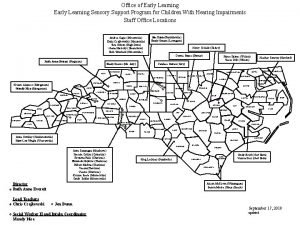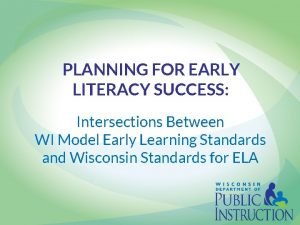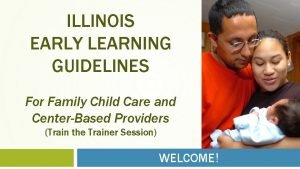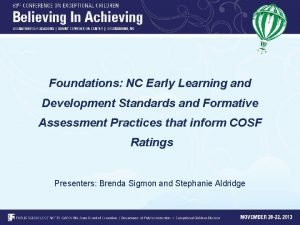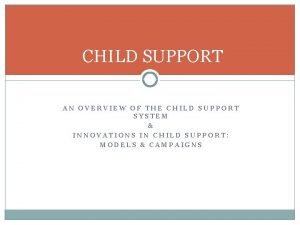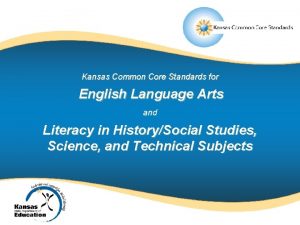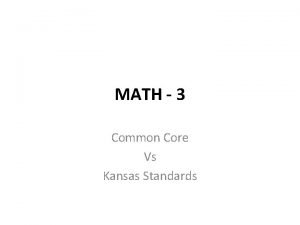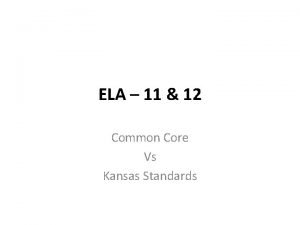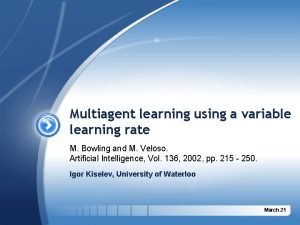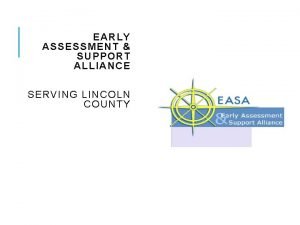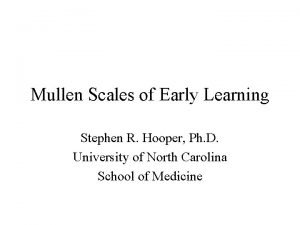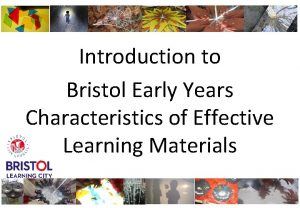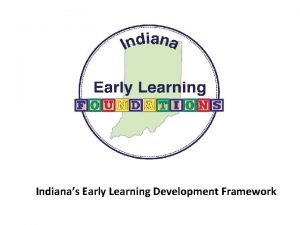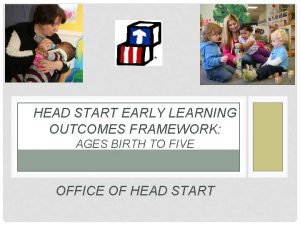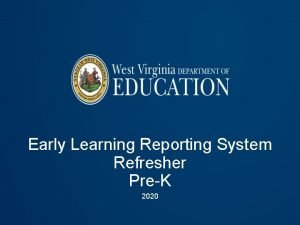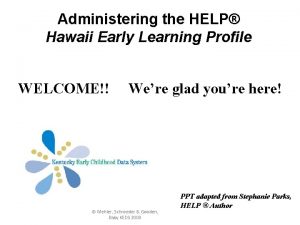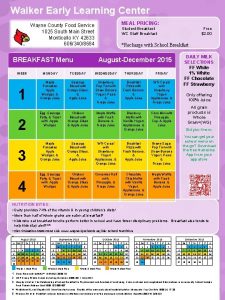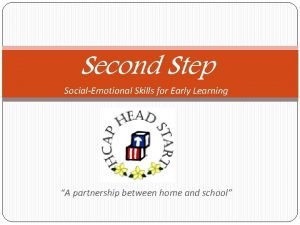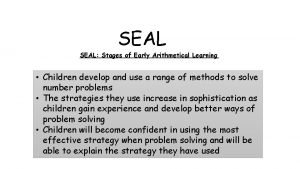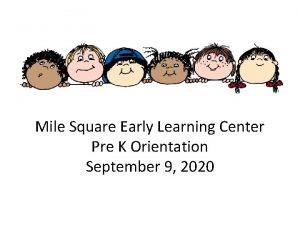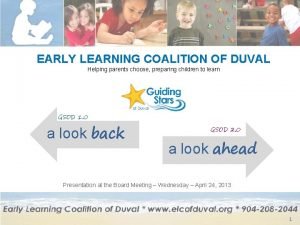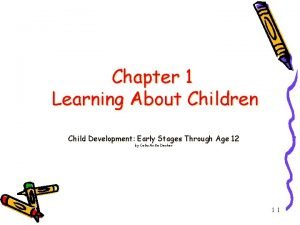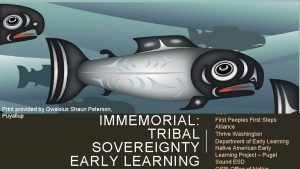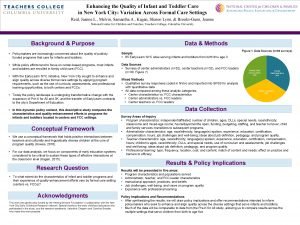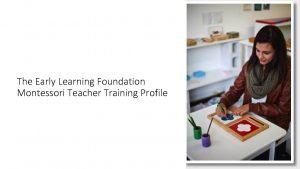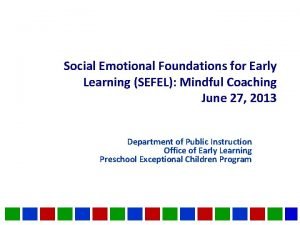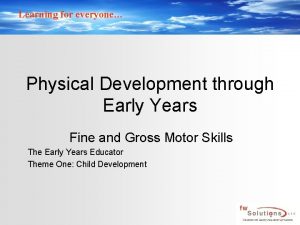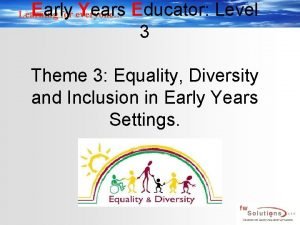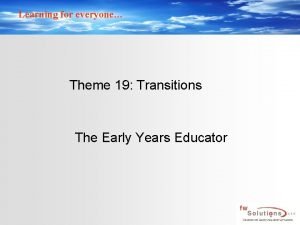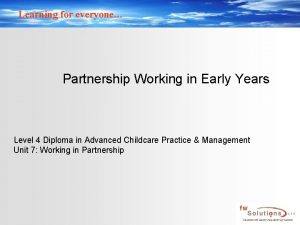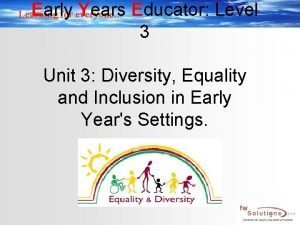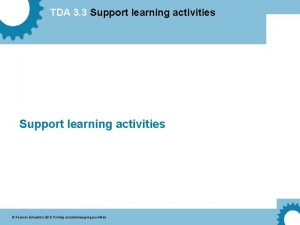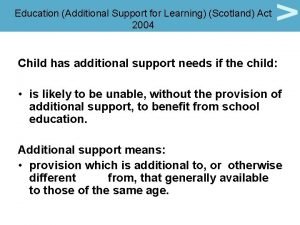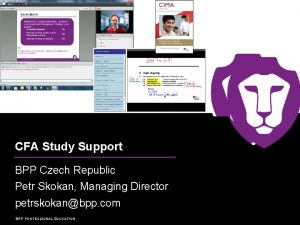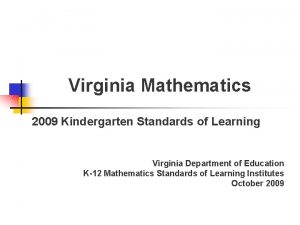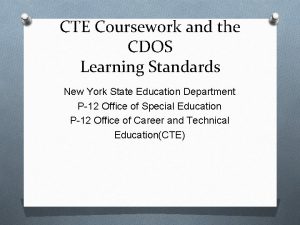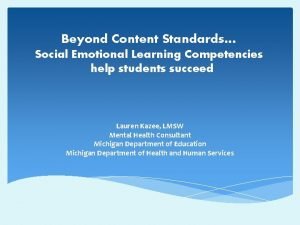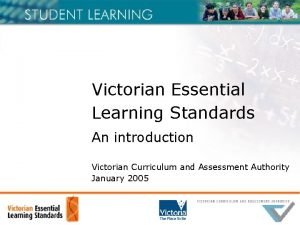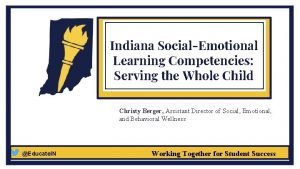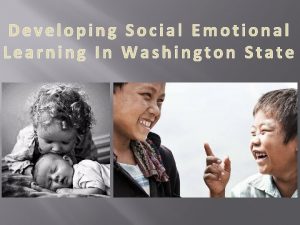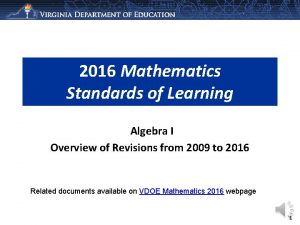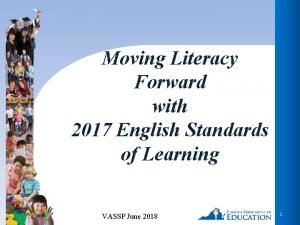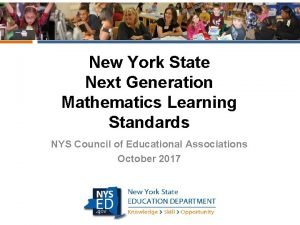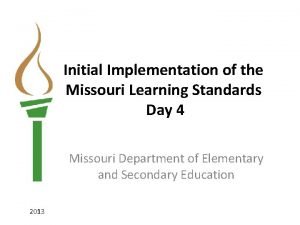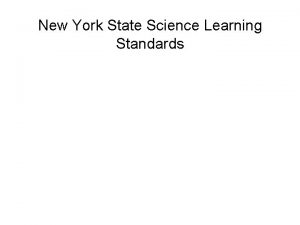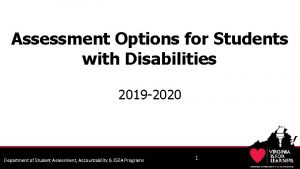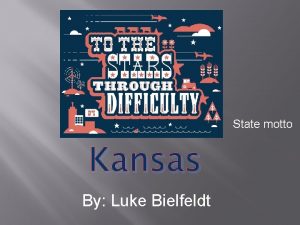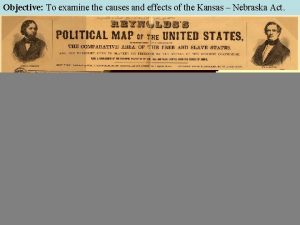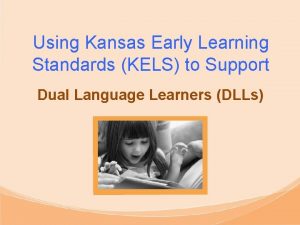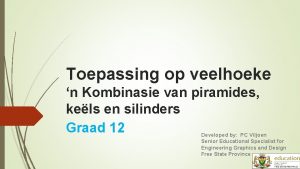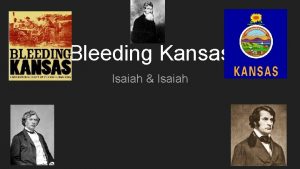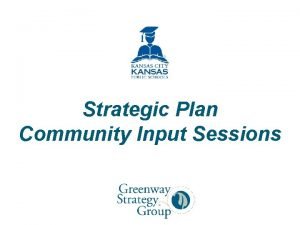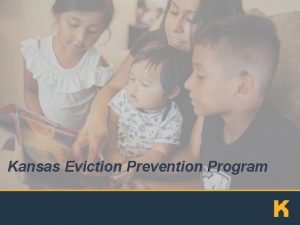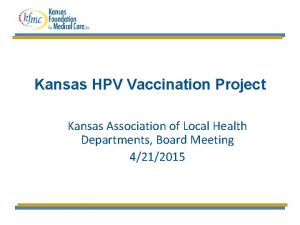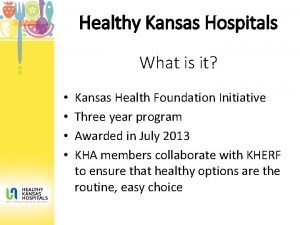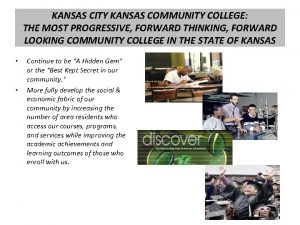Using Kansas Early Learning Standards KELS to Support







































































- Slides: 71

Using Kansas Early Learning Standards (KELS) to Support Developmentally Appropriate Practices and Effective Teaching Strategies

KELS Toolkits • This is one in a series of toolkit presentations developed to guide early care and education providers in appropriate and effective use of the Kansas Early Learning Standards (KELS). • As a pre-requisite to this training, participants should first be familiar with the KELS Overview Toolkit and the KELS document.

How do Kansas Early Learning Standards (KELS) Support DAP? Making the connections: • Conceptual knowledge and skills • Guiding principles from School Readiness Framework • Kansas College and Career Ready Standards (KCCRS) Kansas Early Learning Standards (2014 Revision) http: //www. ksde. org/Portals/0/Early%20 Childhood/ Early%20 Learning%20 Standards/Ks. Early. Learning Standards. pdf

Learner Objectives Participants will: • Increase their understanding of what are Developmentally Appropriate Practices (DAP) and the ways in which the KELS support that practice. • Review the importance of play in early childhood settings and how the KELS can be addressed through play. • Understand the importance of being intentional in both how they teach, what they teach and how the KELS can support that intentionality.

Introduction In this time of standards-based instruction and high stakes testing, it is important to remember that teaching to the standards and teaching in a developmentally-appropriate way are not mutually exclusive, but rather mutually dependent. The KELS were written with this goal in mind: to guide caregivers and teachers with knowledge of what children should be doing at various ages, in various domains with the expectation that they would be used in a developmentally appropriate way.

How do Kansas Early Learning Standards (KELS) Support DAP? As the KELS have moved away from a skill-based format, to one that promotes deeper, conceptual based knowledge, and higher level thinking, it is natural and necessary to include play and experimentation with concepts and ideas using hands on learning to achieve that end.

How do Kansas Early Learning Standards (KELS) Support DAP? “ Children learn through play and active hands on-learning. Adults must use their knowledge to create experiences that are standards-based and child-focused while also meeting the needs the individual children. ” (KELS, p. 1)

What is Developmentally Appropriate Practice (DAP)? DAP is teaching young children in ways that: 1. Meet children where they are as individuals or as a group AND 2. Help each child to reach challenging achievable goals (Copple & Bredekamp, 2006)

Meeting Children Where They Are Requires: • General knowledge of learning and development within the various domains at various ages • Observing children as they interact with their environment and their peers • Learning about individual children’s interests • Observing individual ability and developmental progress (Copple & Bredekamp, 2006)

Three Fundamental Questions for Meeting Children Where They Are: • What is age appropriate • What is individually appropriate • What is appropriate to the social and cultural contexts in which children live (Copple & Bredekamp, 2006; Copple, Bredekamp, Koralek & Charner, 2013)

Helping Children Reach Challenging, Achievable Goals Requires: • Providing materials or experiences that build on what the children already know and can do • Ensuring that activities stretch a child’s current ability towards the next skill to be learned (Copple & Bredekamp, 2006)

DAP is the belief that: • Children learn from constructing their own understanding AND direct instruction by an adult is integral to learning • Children can benefit from engaging in selfinitiated play AND from teacher structured activities and experiences • Children benefit from predictable structure and routines AND teacher flexibility and responsiveness to children’s emerging ideas, needs and interests (Copple & Bredekamp, 2009)

DAP is the belief that: • Children have an enormous capacity to learn along with boundless curiosity AND recognized, age-related parameters on their cognitive and linguistic capacities • It’s important to focus on what you teach AND how you teach it (Copple & Bredekamp, 2009)

DAP is not the belief that: • Direct Instruction is inappropriate • Teachers simply wait for children to mature and develop skills • Challenging subject content should wait until the child is older (Copple & Bredekamp, 2009)

Intentionality is the Cornerstone of DAP • Teaching that meets learners where they are and takes them to challenging new levels doesn’t happen by chance • Intentional teachers not only know what they want to do, how they want to do it, but why they are doing it. They can also articulate it to parents, administrators and colleagues • Intentional teaching can occur in any setting and across all activities

Five Pillars of DAP • • • Create a caring community of learners Teach to enhance development and learning Plan appropriate curriculum Assess children’s development and learning Develop relationships with families (Copple & Bredekamp, 2009)

Five Key Aspects of DAP • • • Create a caring community of learners Teach to enhance development and learning Plan appropriate curriculum Assess children’s development and learning Develop relationships with families

Creating a Caring Community Environments are Inclusive: • Caregivers and teachers use necessary supports and strategies to ensure individual needs are met and each child is able to interact successfully • Caregivers and teachers work to build a strong sense of group identity among the children by planning ways for students to collaborate in work and play • Social and cultural contexts in which the children live are valued within the group

Creating a Caring Community Physical Environment is safe and inviting: • Children and adults have easy access to each other • Spaces are clearly defined • Materials and equipment meet health and safety guidelines for the ages of the children that environment serves • Materials are well organized and easily accessible to children • Materials and activities are changed routinely to meet the interests and learning needs of the children as they grow

Creating a Caring Community Schedules are well thought out: • They are predictable and follow a routine, but not rigid • There is a balance of active movement and quiet time • Both direct instruction and ample time for students to learn through play are included

Creating a Caring Community Schedules are well thought out (continued): • Extended blocks of time in which children can engage in sustained play are included in the schedule • Children have the opportunity to choose from a number of learning centers and participate in a variety of groups, large and small of which are intentionally set up to support children in acquiring important knowledge and skills • Transitions are planned and scheduled throughout the day

Creating a Caring Community Teachers are responsive to children’s feelings and build positive relationships with them by: • Prioritizing warm, caring relationships with each child and providing an emotionally safe climate • Fostering conversations with the children about things that interest them • Listening to and acknowledging children’s feelings and giving them feedback that guides them in resolving their own conflicts

Creating a Caring Community Teachers are responsive to children’s feelings and build positive relationships with them by: • Setting clear and reasonable limits and applying them consistently • Valuing mistakes and misbehavior as an opportunity for learning • Providing specific positive feedback regarding their accomplishments

Creating a Caring Community The KELS links to creating a caring community by providing some guidance through the standards of skills children should have from infancy through Kindergarten. For example: • SED. SD. i. 1 - Reacts to emotional expression of others • SED. SD. mi. 1 - Demonstrates awareness of feelings expressed by others • SED. SD. t. 2 - Responds in caring ways to another's distress in some situations • SED. SD. p 3. 1 - Expresses concern for the needs of others and people in distress • SED. SD. p 4. 1 - Demonstrates an understanding of and responds to needs of others and people in distress What other standards can you identify that might also address creating a caring community?

Five Key Aspects of DAP • • • Create a caring community of learners Teach to enhance development and learning Plan appropriate curriculum Assess children’s development and learning Develop relationships with families

Teach to Enhance Learning and Development Scaffold Learning: Providing students with the least amount of support necessary to do something they cannot quite achieve on their own. Types of Scaffolding: • • • Asking questions Providing hints and clues Providing verbal or visual prompts Modeling Adapting the activity or materials Providing physical assistance (Copple, Bredekamp, Koralek, & Charner, 2013)

Teach to Enhance Learning and Development Use a Variety of formats: • Large groups - involve the whole class and are used for teaching specific information and helping students learn to function as a part of a community • Small groups - involve either a group of 3 -5 students and focus on either a new skill or application of a concept already introduced • Play/Learning Centers - are intentionally developed centers with materials that support educational outcomes and allow children to further their learning at their own pace and in a variety of ways • Home based program - supporting parents to enhance their childes skill development

Teach to Enhance Learning and Development Use both teacher directed and child initiated learning: Skills included in the KELS should be introduced by a teacher during whole group or small group instruction and then through intentional planning they are practiced in child-initiated play.

Teach to Enhance Learning and Development Provide extended time for sustained play, investigations, and interactions: • Set up specific play situations which incorporate the KELS • Ask questions to extend thinking during play • Infuse the KELS into the child’s play through conversations and scenarios

Importance of Play Content is learned through investigation and play. Children learn by exploring, thinking about, and inquiring about all sorts of things. These experiences help children investigate “big ideas, ” those that are important at any age and are connected to later learning. (Clements & Sarama, 2009)

Importance of Play It is important to remember in DAP there is no “free play” but rather intentionally organized play that supports children to move from simplistic repetitive play into highly organized, complex and sustained play where they play with a purpose to develop refined skills in a variety of areas. (Gronlund, 2010)

Benefits of Play • Conceptual Understanding • Increased Language and Literacy Skills • Increased Memory • Increased Attention Span

Benefits of Play • Increased Problem Solving • Emotional Regulation • Increased Interpersonal Skills

Recommendations for Play • Provide ample time for children to engage in sustained play • Provide enough materials for all children to be actively engaged at their development level at all times • Materials in the play areas should support literacy, math, science, social Studies, creative arts, and social emotional skills • Provide open ended activities that foster exploration, questioning, problem solving and self discovery

Standards and Play Standards remove the confusion regarding what children are able to do, by describing their thinking and capabilities in various domains at various age levels. They then can be used as a guide for setting up play situations that take children’s learning to the next level.

Standards and Play • How would you incorporate the following standards into play based learning • CL. F. p. 4. 1 c - Recognizes the letters are grouped to form words • M. G. p 4. 1 - Describes objects in the environment using names of shapes and describes the relative positions of these objects using terms (e. g. above, below, beside, in front of, behind)

Five Key Aspects of DAP • • • Create a caring community of learners Teach to enhance development and learning Plan appropriate Curriculum Assess children’s development and learning Develop relationships with families

Plan Appropriate Curriculum KELS defines curriculum as “the organized, planned, content of learning, it identifies a sequence of skills or knowledge that a child may exhibit and is structured around a philosophy regarding how children learn. ” (KELS, 2014, p. 7, 8) Curriculum, simply stated, is what children should know and how it should be taught. (Hyson, 2008)

Plan Appropriate Curriculum Remember: The KELS are NOT designed to serve as a curriculum, however they are designed to be used as a guide when developing or selecting a curriculum. They provide a outline for appropriate developmental sequences and outcomes in each of the domains for children zero to five. (KELS, 2014)

Plan Appropriate Curriculum Comprehensive curriculum includes multiple domains such as: Social Emotional Literacy Language Math Science Physical Development Creative Arts Social Studies No one area is more important than any other and they are all interrelated.

Plan Appropriate Curriculum is more than a collection of activities. • Curriculum is based on key outcomes, such as the KELS, for children and provides the framework for choosing those experiences that fit together to accomplish the outcomes • Making meaningful connections should be a priority in curriculum planning (Copple & Bredekamp, 2006)

Plan Appropriate Curriculum is thoughtfully structured to build on and advance children’s skills toward outcomes • Content and sequence are not left to chance • Caregivers and teachers are familiar with key content and skills in each domain • The developmental paths that children follow should be used to determine the sequence and pace of the learning experience (Copple &Bredekamp, 2006)

Plan Appropriate Curriculum The intentional teacher is purposeful and guided by the outcomes they want their children to achieve: • They infuse the day with specific outcomes • They recognize teachable moments when working and respond in a way that supports the learner to develop a deeper level of understanding • They adapt the curriculum to meet the needs of individual students

Plan Appropriate Curriculum When selecting or developing a new curriculum it is important that curriculum be aligned, especially between Pre-K and K-3. This alignment allows Pre-K teachers to use valuable practice from the K-3 world, such as robust content, and attention to learning progressions. In turn K 3 teachers can incorporate effective preschool practices of attention to the whole child, active, hands on learning and integrated parent engagement. Like wise it is also important to align Birth-Pre-K standards to ensure all that we are doing supports the whole child and provides the foundation for future success in life. (Copple, Bredekamp, Koralek, & Charner, 2013)

Five Key Aspects of DAP • Create a caring community of learners • Teach to enhance development and learning • Plan appropriate curriculum • Assess children’s development and learning • Develop relationships with families.

Assess Children’s Development and Learning Curriculum vs. Assessment “Curriculum is the plan for enabling children to reach desired outcomes; assessment is the process of looking at children’s progress toward those outcomes. ” (Copple & Bredekamp, 2006, p. 47)

Assess Children’s Development and Learning Why We Assess in DAP Programs • Monitor learning and development • Guide planning and decision making • Identify Children who might benefit from special services and/or supports • Communicate to others (e. g. parents, other community programs, state agencies)

Assess Children’s Development and Learning Recommended Practices When Conducting Assessment: • Describe what the child does, not what the child has • Use a developmental approach • Gather data/information over time, at different times of the day and different settings • Get an ecological view (from the child to his/her family to the community), not a child-only view • Use a team of individuals to partner with when assessing a child to make decisions

Assess Children’s Development and Learning Use of the KELS with Assessment: • The KELS is NOT an assessment, but it can be used as a guide or framework to assessment. • It promotes use for ALL children • It provides key developmental skills, or early academic skills expected by each child, so it can show what a child, at a specific age, should be able to do • The KELS promotes “ongoing and frequent collection of universal screening and progress monitoring data” (KELS, 2014, p. 2)

Assess Children’s Development and Learning KELS as a Guide to Assessment: • Both the KELS and early childhood assessments are designed to reflect skills that children typically develop. The KELS helps through knowing and understanding: • Development – key milestones • Development – as a linear guide for kindergarten readiness • Alignment with commercial tests and tools, and informal assessment tools • It supports conversations linked to program evaluation with professionals, staff, caregivers, and parents

Assess Children’s Development and Learning Putting it into Practice: • Intentional planning – using the KELS • Begin with assessment of each child’s current skills, interests, learning styles, cultural norms, and prior experiences • Identify an appropriate activity based on the children’s interests and learning goals • Link this to the relevant standard(s) based on the goals for child learning during the activity

Assess Children’s Development and Learning Putting it into Practice: • Determine possible individual needs of children and prepare for adaptations and accommodations • Implement the activity, documenting children’s responses and abilities to the activity

Assess Children’s Development and Learning Putting it Into Practice: • Use assessment tools to note skills demonstrated, use notes about children’s reactions, questions and comments • Reflect on and evaluate the activity to determine if children did not meet, almost met, or met the learning goal(s) • Based on findings, design plans to meet individual child needs

Five Key Aspects of DAP • Create a caring community of learners • Teach to enhance development and learning • Plan appropriate curriculum • Assess children’s development and learning • Develop relationships with families

Develop Relationships with Families Steps to Success: • Recognize that the family is the FOUNDATION for all growth and learning (they are the first and most influential teacher) • Know families as COMMUNICATORS (families and program staff consistently initiate and respond to each other through multiple methods, always honoring cultural and linguistic norms/needs)

Develop Relationships with Families Steps to Success • Acknowledge and support families as active advocates and decision-makers (give them informed options, active leadership, and provide needed resources) • Engage families as partners (working together)

Develop Relationships with Families Research/Evidence-Based Facts: • Partnering with parents/family members has been shown to increase developmental and later academic skill levels (Editorial Projects in Education Research Center, 2004; Epstein, 2011; Snow, K. , 2015) • One way to partner with parents is to use the KELS (which used research/evidence-based resources in its development) as a guide to understanding what is expected of the child, and what the parent can do within home and community environments to promote skills

Develop Relationships with Families. The KELS Encourages Parent Partnerships: • By using a “common language within the KELS from which parents and professionals can discuss children’s capabilities and accomplishments” (KELS, 2014, p. 7) • The KELS is dedicated to helping “parents, teachers and all caregivers…create safe, stable and consistent environments that provide repeated opportunities for learning. ” (KELS, 2014, p. 9)

Develop Relationships with Families Ideas for Parent Involvement: • Parenting: help them understand child development and learning and provide resources in their home language • Communicating: ask how the parent prefers to communicate (e. g. , in-person, phone, technology) and honor their choice • Volunteering: recruit and train to help at day care or school (Epstein’s Framework of Six Types of Involvement, 2011)

Develop Relationships with Families Ideas for Parent Involvement: • Learning at Home: develop learning activities at home that fit into daily routines, not that add to their work load • Decision Making: use parent panels or parent questionnaires to provide input and involvement for policies and procedures. • Collaborating with Community: do more than give them a list or a flyer; provide and help them access services & resources (Epstein’s Framework of Six Types of Involvement, 2011)

In addition to the KELS, Kansas recently developed family engagement standards with resources for additional ideas.

To Summarize: Through developmentally appropriate practices we create a safe, nurturing, supportive places for young children to experience the joys of childhood. The truest measure of success as early childhood caregivers and educators comes from seeing children joyfully, physically, and intellectually engaged in meaningful learning about their world and everyone and everything in it. (Copple, Bredekamp, Koralek, & Charner, 2013)

Evaluation • What is one big idea or take home message from what you heard today • What excites you or concerns you about what you learned • Any insights from the session • How will you use what you learned from this session

For More Information KELS Virtual Toolkit: DAP • QT • I need a better understanding of this topic. Where should I begin • How do I find out what works to support infants and young children in this area • Show me what implementation looks like (for adults and children) in classroom and non-classroom settings • How can I get additional training on this topic • I would like to share this information with others, in a group setting. Is there a trainer's version of this virtual toolkit • Evaluation

References Copple, C. Bredekamp, S. , Koralek, D. , & Charner, K. ( 2013). Developmentally appropriate practice: focus on preschoolers. Washington, DC: National Association for the Education of Young Children. Copple, C. , & Bredekamp, S. (2009). Developmentally appropriate practice in early childhood programs serving children birth through age eight (Third ed. ). Washington, DC: National Association for the Education of Young Children. Copple, C. , & Bredekamp, S. (2006). Basics of developmentally appropriate practice an introduction for teachers of children three to six. Washington, DC: National Association for the Education of Young Children. Clements, D. , & Sarama, J. (2009). Learning and teaching early math: the learning trajectories approach. New York, NY: Routledge.

References Division for Early Childhood (DEC) (2005). Promoting positive outcomes for children with disabilities: Recommendations for curriculum, assessment and program evaluation the DEC companion paper to the NAEYC and NAECS/SDE 2003 joint position statement Early childhood curriculum, assessment, and program evaluation: building an effective accountable system in programs for children birth through age eight. Drew, W. F. , Christie, J. , Johnson, J. E. , Meckley, A. M. , & Neil, M. L. (2008). Constructive play: A value added strategy for meeting early learning standards. Young Children Journal of the National Association for the Education of Young Children, 63(4), 38 -46. Editorial Projects in Education Research Center (2004, August 4). Issues A-Z: Parent Involvement. Education Week. Retrieved http: //www. edweek. org/ew/issues/parent-involvement Epstein (2011). School, family, and community partnerships: Preparing educators and improving schools. Second Edition. Boulder, CO: Westview Press.

References Epstein, A. S. (2007) The intentional teacher choosing the best strategies for young children's learning. Washington, DC: National Association for the Education of Young Children Gronlund, G. (2010) Developmentally appropriate play guiding young children to a higher level. St. Paul, MN: Red Leaf Press. Honig, A. S. (2007) Play-ten power boosts for children's early learning. Young Children, 62(5), 72 -76. Hyson, M. (2008) Enthusiastic and engaged learners approaches to learning in the early childhood classroom. New York, NY: Teachers College Press. Kansas Early Learning Standards Committee (2014) Kansas Early Learning Standards: Building the Foundations for Successful Children. Topeka, KS: Kansas State Department of Education. http: //www. ksde. org/Portals/0/Early%20 Childhood/Early%20 Le arning%20 Standards/Ks. Early. Learning. Standards. pdf

References NAEYC (2009) Developmentally appropriate practice in early childhood programs serving children from birth through age 8. Available at http: //www. naeyc. org/positionstatements/dap NAEYC and NAECS/ SDE(2003) Joint position statement early childhood curriculum, assessment, and program evaluation: building an effective accountable system in programs for children birth through age 8. Available at: http: //www. naeyc. org/positionstatements/cape Snow, K. (2015) Research news you can use: Family engagement and early childhood education. National Association for the Education of Young Children. Retrieved from: http: //www. naeyc. org/content/research-news-family-engagement White, R. (2012) The power of play; research summary on play and learning. Retrieved from: https: //www. mcm. org/uploads/MCMResearch. Summary. pdf

Acknowledgement The Kansas Early Learning Standards (KELS) Training Project, a project of the University of Kansas, Life Span Institute at Parsons, was funded through a grant from the Kansas State Department of Education with funds from the Kansas Children’s Cabinet and Trust Fund. Leadership support for this project was provided by the Kansas State Agencies Early Childhood Leadership Team with representatives from: • Kansas Children’s Cabinet and Trust Fund • Kansas Department for Children and Families • Kansas Department of Health and Environment • Kansas State Department of Education

Contacts Kansas Children’s Cabinet and Trust Fund Landon State Office Building 900 SW Jackson St. , Rm. 152 Topeka, Kansas 66612 785. 368. 7044 or 877. 204. 5171 Kansas Department for Children and Families Strengthening Families 555 S. Kansas Avenue Topeka, Kansas 66603 785. 296. 3271 or 800. 332. 6262 Kansas Department of Health and Environment Bureau of Family Health Curtis State Office Building 1000 SW Jackson St. , Suite 220 Topeka, Kansas 66612 785. 291. 3368 or 800. 332. 6262 Kansas State Department of Education Early Childhood, Special Education, and Title Services Landon State Office Building 900 SW Jackson St. Topeka, Kansas 66612 785. 296. 7454 or 800. 203 -9462

Acknowledgement Suggested reference for this Power. Point: Heintz, C. , Rinkel, P. , Mitchell, L. , & Lindeman, D. P. (2016). Using Kansas Early Learning Standards (KELS) to Support: Developmentally Appropriate Practice (DAP). Life Span Institute at Parsons, University of Kansas, Parsons, KS.
 Kansas kansas state fight
Kansas kansas state fight Early learning sensory support program
Early learning sensory support program Wmels 5 domains
Wmels 5 domains Illinois early learning guidelines
Illinois early learning guidelines Nc early learning standards
Nc early learning standards Kansas child support arrears forgiveness
Kansas child support arrears forgiveness Kansas ela standards
Kansas ela standards Math standards kansas
Math standards kansas Kansas ela standards
Kansas ela standards Multiagent learning using a variable learning rate
Multiagent learning using a variable learning rate Early cpr and early defibrillation can: *
Early cpr and early defibrillation can: * Cuadro comparativo e-learning m-learning b-learning
Cuadro comparativo e-learning m-learning b-learning Early assessment and support alliance
Early assessment and support alliance Eyitt course
Eyitt course Major vs minor details
Major vs minor details Standards for commercial support
Standards for commercial support Factors necessary for appropriate service standards
Factors necessary for appropriate service standards Hgioelc examples
Hgioelc examples Oregon early learning and kindergarten guidelines
Oregon early learning and kindergarten guidelines Stages of early arithmetical learning
Stages of early arithmetical learning Mullen scale scoring
Mullen scale scoring Bristol characteristics of effective learning
Bristol characteristics of effective learning Indiana early learning foundations
Indiana early learning foundations Head start early learning outcomes framework
Head start early learning outcomes framework Early years learning framework overview
Early years learning framework overview Wv elrs
Wv elrs Hawaii early learning profile
Hawaii early learning profile Walker early learning center
Walker early learning center Second step social emotional skills for early learning
Second step social emotional skills for early learning Stages of early arithmetical learning
Stages of early arithmetical learning Mile square early learning center
Mile square early learning center Early learning coalition of duval
Early learning coalition of duval Chapter 1 learning about children
Chapter 1 learning about children Since time immemorial early learning curriculum
Since time immemorial early learning curriculum Adelphi early learning center
Adelphi early learning center Mtt teacher training
Mtt teacher training Social and emotional foundations for early learning
Social and emotional foundations for early learning Early learning for everyone
Early learning for everyone Early learning for everyone
Early learning for everyone Developmental sequence linguistics
Developmental sequence linguistics Early learning for everyone
Early learning for everyone Partnership working in early years
Partnership working in early years Early learning for everyone
Early learning for everyone Chapter 9 early childhood cognitive development
Chapter 9 early childhood cognitive development Tda 3.3 support learning activities
Tda 3.3 support learning activities Lsfnhs
Lsfnhs Additional support for learning act 2004
Additional support for learning act 2004 Bpp learning support
Bpp learning support Lsfas
Lsfas 2009 mathematics standards of learning answers
2009 mathematics standards of learning answers Cdos standards
Cdos standards Social emotional learning standards michigan
Social emotional learning standards michigan Victorian essential learning standards
Victorian essential learning standards Social emotional learning standards nj
Social emotional learning standards nj Idoe science of happiness
Idoe science of happiness Social emotional learning washington state
Social emotional learning washington state Algebra 1 sol standards
Algebra 1 sol standards 2017 english standards of learning curriculum framework
2017 english standards of learning curriculum framework 2016 mathematics standards of learning
2016 mathematics standards of learning Nys next generation math standards
Nys next generation math standards How to write missouri learning standards
How to write missouri learning standards New york state standards science
New york state standards science Vaap manual
Vaap manual System.collections.generics
System.collections.generics Accumulator ac
Accumulator ac Hyatt regency walkway disaster
Hyatt regency walkway disaster Walkway collapse in kansas city
Walkway collapse in kansas city State motto for kansas
State motto for kansas Nurse practice act kansas
Nurse practice act kansas Kansas-nebraska act effects
Kansas-nebraska act effects Lorain county section 8
Lorain county section 8 Kansas assessment examiner's manual
Kansas assessment examiner's manual

